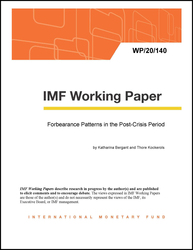
Forbearance Patterns in the Post-Crisis Period
Forbearance Patterns in the Post-Crisis Period
READ MORE...
Volume/Issue:
Volume 2020
Issue 140
Publication date: July 2020
ISBN: 9781513550817
$5.00
Add to Cart by clicking price of the language and format you'd like to purchase
Available Languages and Formats
| English |
Prices in red indicate formats that are not yet available but are forthcoming.
Topics covered in this book
This title contains information about the following subjects.
Click on a subject if you would like to see other titles with the same subjects.
Banks and Banking , Money and Monetary Policy , WP , risky borrower , outstanding balance , x Time , bank characteristic , borrower rating , interest rate , Time level , rating class , Loans , Nonperforming loans , Capital adequacy requirements , Credit , Credit risk , Global , Non-Performing Loans , Zombie Lending , Banking Regulation
Summary
Using supervisory loan-level data on corporate loans, we show that banks facing high levels of non-performing loans relative to their capital and provisions were more likely to grant forbearance measures to the riskiest group of borrowers. More specifically, we find that risky borrowers are more likely to get an increase in the overall limit or the maturity of a loan product from a distressed lender. As a second step, we analyse the effectiveness of this practice in reducing the probability of default. We show that the most common measure of forbearance is effective in the short run but no forbearance measure significantly reduces the probability of default in the long run. Our evidence also suggests that forbearance and new lending are substitutes for banks, as high shares of forbearance are negatively correlated with new lending to the same group of borrowers. Taken together, these findings can help policy makers shape surveillance and regulation in a future recovery from the Covid-19 pandemic.
Copyright © 2010 - 2025
Powered by:
AIDC



